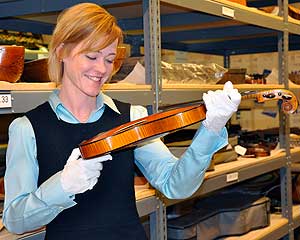Antonio Stradivari reportedly crafted some 1,100 stringed instruments in the northern Italian city of Cremona and died a celebrated artist whose creations are coveted by musicians and collectors the world over.
Why has the Stradivarius continued to set the standard of musical perfection, commanding more than $3.5 million at a Christie’s auction in 2006?

Chanot Violin, T2008.113.9, Musical Instrument Museum, Phoenix, Arizona
Christina Linsenmeyer gingerly handles a Chanot Violin in her work as curator of musical instruments at the Musical Instrument Museum in Phoenix. When the facility opens next year, it will be the nation’s first freestanding museum devoted to musical instruments of world cultures.
Ask Christina Linsenmeyer. Her dissertation research, twice funded by WUSTL’s Nussbaum Award for Doctoral Student Travel, took her into the museums and libraries of London, Brussels, Antwerp and Paris to seek the answers.
“Stradivari violins, like the Mona Lisa, are determined by cultural perception,” says Linsenmeyer, who will receive a doctorate in musicology in Arts & Sciences.
“Even in Paris, the 19th-century center of violin-making, the violin, unlike other instruments, remained grounded in the 18th century.”
In her dissertation, Linsenmeyer orients the violin as a cultural object in the histories of art, science and commerce to better understand the object’s meaning and value.
Combing international repositories to substantiate her claims was a far cry from what Linsenmeyer envisioned for herself growing up in Baltimore. Although musically inclined — she began piano lessons at 6 and cello at 9 — she had set her sights on becoming an astronaut, enrolling at Colgate University to study astronomy and physics.
“My love for music really came into focus in college,” says Linsenmeyer, who also plays the viola da gamba. “This had a lot to do with my professors, the students and the well-established music ensembles.
“I realized then that music was a metaphor for everything in life: learning, communication, self-discovery and facing challenges,” she says.
Linsenmeyer graduated from Colgate University with a bachelor’s degree in music with honors. Knowing that she eventually would pursue a doctorate, she decided she would first learn how to make violins.
“I’d done some woodworking prior and liked working with my hands,” she says.
A few years later, with a certificate in violin-making and restoration from North Bennet Street School in Boston and experience repairing and dealing violins, Linsenmeyer launched her doctoral studies.
Along the way, she grew discouraged by the static presentations she observed in museums.
“Most museums put an instrument in a glass case, slap a label on it and call it art,” she says. “They don’t provide enough context for the public to understand the role and value of the objects. That’s one reason I’m so excited about the Musical Instrument Museum (MIM), which makes that communication a priority.”
The MIM, a 190,000-square-foot museum under construction in Phoenix, already has snagged Linsenmeyer to serve as curator of musical instruments. (She got the job in August 2008, another reason for her excitement.)
| Graduate School of Arts & Sciences |
The nation’s first freestanding museum devoted to musical instruments of world cultures, the MIM will house state-of-the-art audio and video exhibits, a concert hall, a cross-disciplinary research center and a conservation lab. The opening is slated for spring 2010.
“As a graduate student leader, Christina leaves a legacy that has impacted the quality of graduate education at the University and beyond,” says Elaine Berland, Ph.D., associate dean in the Graduate School of Arts & Sciences and founding director of the National Conference on Graduate Student Leadership.
“Christina’s participation as graduate student coordinator of the first two National Conferences on Graduate Student Leadership, convened in 2003 and 2005 by the Woodrow Wilson National Fellowship Foundation and WUSTL, sparked leadership action among graduate students across the country,” Berland says, “and helped set a high standard for subsequent conferences.”
Linsenmeyer also has been recognized for outstanding service by the Graduate Student Senate, where she served as co-president, and by the Graduate and Professional Council.
She helped to establish the University-wide Peer Mentoring Program and the Outstanding Faculty Mentor Awards.
“All of my experiences have led me to the Musical Instrument Museum, where visitors will not only hear but also see the instruments being played in their cultural context,” Linsenmeyer says. “It’s about time!”